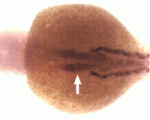In Development this week (Vol. 138, Issue 4)
Posted by Seema Grewal, on 26 January 2011
Here are the research highlights from the current issue of Development:
New moves in haematopoiesis: rumba and samba

Vertebrate haematopoiesis relies on a pool of haemetopoietic stem/progenitor cells (HSPCs) that can self-renew and differentiate into all haematopoietic lineages. But what are the molecular mechanisms that regulate this process? Here, Zilong Wen and co-workers (p. 619) identify two novel factors that regulate zebrafish HSPC maintenance. During zebrafish development, HSPCs originate from the ventral wall of the dorsal aorta (VDA), migrate to the caudal haematopoietic tissue (CHT) and finally colonise the kidney. The researchers isolated and characterised two haematopoiesis-deficient mutants, rumbahkz1 and sambahkz2. In these mutants, HSPC specification in the VDA and subsequent homing to the CHT are normal, but further HSPC development within the CHT is compromised. Using positional cloning, they show that Rumba is a novel nuclear C2H2 zinc-finger protein and that samba encodes a protein that is homologous to human augmin complex subunit 3 (Haus3). Both factors, they report, act independently and cell-autonomously to regulate cell cycle progression in HSPCs, and thus are essential regulators of zebrafish haematopoiesis.
Pancreatic Hh signalling: a play in two acts

In amniotes, inhibition of hedgehog (Hh) signalling in the early embryonic endoderm is a prerequisite for pancreatic specification. By contrast, loss of Hh signalling in zebrafish severely disrupts pancreas development, suggesting opposite roles for Hh signalling in fish versus mammalian pancreas organogenesis. Zahra Tehrani and Shuo Lin (p. 631) now reconcile these contrasting functions by showing that the Hh pathway plays distinct roles during various stages of zebrafish pancreas development. Using genetic and pharmacological approaches to temporally modulate Hh activity, they show that Hh activity during early gastrulation is essential for the subsequent migration and differentiation of pancreatic precursors. This positive role of Hh acts to restrict Bmp signalling and to promote β-cell differentiation. By the end of gastrulation, they report, Hh signalling adopts a negative role by antagonizing retinoic acid (RA)-mediated induction of endocrine pancreatic precursors. These findings highlight sequential roles for Hh signalling in pancreas development and uncover antagonistic relationships between the Hh, Bmp and RA pathways during pancreas organogenesis.
Sox9+ progenitors make β-cells in embryo but not in adult

All pancreatic cell types, including insulin-producing β-cells, arise from pancreatic progenitors during embryonic development, but whether the adult pancreas contains β-cell progenitors remains a controversial issue. Using fate-mapping studies in mice, Maike Sander and colleagues (p. 653) now demonstrate that cells positive for Sox9 give rise to β-cells during embryogenesis, but not in the normal or injured adult pancreas. They generated Sox9CreERT2 mice in which Sox9-expressing cells can be accurately and temporally labelled. Lineage tracing shows that these cells can generate all pancreatic lineages during embryogenesis. By contrast, they report, endocrine and acinar cell neogenesis from Sox9-positive cells does not occur in the adult pancreas. Using partial duct ligation (PDL) to induce pancreatic injury, they also show that Sox9-positive cells do not generate β-cells following injury; PDL initiates pre-endocrine programs but not complete β-cell differentiation. Given the increasing use of PDL as a model to study β-cell regeneration, these studies provide important insights into the specification and regeneration of β-cells.
The first author of this paper has also written a post about these exciting discoveries.
engrailed links Hh and Bmp muscle development signals

Myotome morphogenesis requires the specification of distinct muscle cell types. In zebrafish, the specification of medial fast-twitch fibres (MFFs) and slow-twitch muscle pioneers (MPs), both of which express engrailed (eng) genes, is regulated by hedgehog (Hh) signalling but the mechanistic basis of this regulation is unclear. On p. 755, Philip Ingham and co-workers demonstrate that the eng2a promoter integrates repressive and activating signals from the Bmp and Hh pathways, respectively, to limit its expression to MFFs and MPs during zebrafish myotome development. The researchers identified a minimal element in the eng2a promoter that can drive reporter gene expression specifically in MFFs and MPs. This element binds both Gli2, a mediator of Hh signalling, and activated Smads, mediators of Bmp signalling. They demonstrate that Hh activity antagonises Smad activation in myotomal cells and, conversely, that aberrant Smad activation suppresses eng2a expression. Their studies identify novel crosstalk between the Hh and Bmp pathways that may be mediated by direct interactions between Gli and Smad proteins.
Non-embryonic Nodals orchestrate early development

Vertebrate development and patterning require Nodal signalling. However, the upstream inducers of Nodal expression and the relative contributions of Nodal ligands from embryonic, extraembryonic and maternal sources to embryogenesis are unclear. Now, Benjamin Feldman and co-workers show that non-embryonic sources of Nodal-related ligands, activated in part by the transcription factor Mxtx2, account for the spectrum of zebrafish early Nodal signalling events (p. 787). They report that Mxtx2 activates and is required for the expression of nodal-related 2 (ndr2) in the yolk syncytial layer, an extraembryonic tissue, thus identifying a novel upstream component of Nodal signalling. They further demonstrate that the co-disruption of extraembryonic ndr2, extraembryonic nodal-related 1 (ndr1) and maternal ndr1 recapitulates Nodal mutant phenotypes: embryos show a loss of endoderm and anterior mesoderm specification. Based on their findings, the authors propose that endoderm and anterior mesoderm specification during zebrafish development is executed by a failsafe mechanism involving the combined action of non-embryonic Nodal-related ligands, and that this mechanism may be relevant to higher vertebrates.
Plus…
Technical advances, together with increasing collaborations between experimentalists and theorists, have highlighted the importance of stochasticity in cell and developmental biology. As reviewed by Andy Oates, this was explored in detail at the Company of Biologists’ recent workshop in Windsor, UK. See the Meeting Review on p. 601
Also see the earlier post by Fernando Casares about this meeting


 (1 votes)
(1 votes)